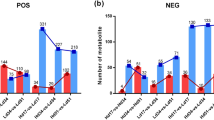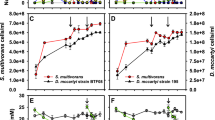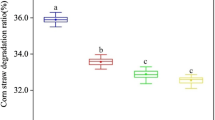Abstract
Dehalococcoides ethenogenes strain 195 (DE195) was grown in a sustainable syntrophic association with Desulfovibrio vulgaris Hildenborough (DVH) as a co-culture, as well as with DVH and the hydrogenotrophic methanogen Methanobacterium congolense (MC) as a tri-culture using lactate as the sole energy and carbon source. In the co- and tri-cultures, maximum dechlorination rates of DE195 were enhanced by approximately three times (11.0±0.01 μmol per day for the co-culture and 10.1±0.3 μmol per day for the tri-culture) compared with DE195 grown alone (3.8±0.1 μmol per day). Cell yield of DE195 was enhanced in the co-culture (9.0±0.5 × 107 cells per μmol Cl− released, compared with 6.8±0.9 × 107 cells per μmol Cl− released for the pure culture), whereas no further enhancement was observed in the tri-culture (7.3±1.8 × 107 cells per μmol Cl− released). The transcriptome of DE195 grown in the co-culture was analyzed using a whole-genome microarray targeting DE195, which detected 102 significantly up- or down-regulated genes compared with DE195 grown in isolation, whereas no significant transcriptomic difference was observed between co- and tri-cultures. Proteomic analysis showed that 120 proteins were differentially expressed in the co-culture compared with DE195 grown in isolation. Physiological, transcriptomic and proteomic results indicate that the robust growth of DE195 in co- and tri-cultures is because of the advantages associated with the capabilities of DVH to ferment lactate to provide H2 and acetate for growth, along with potential benefits from proton translocation, cobalamin-salvaging and amino acid biosynthesis, whereas MC in the tri-culture provided no significant additional benefits beyond those of DVH.
Similar content being viewed by others

Login or create a free account to read this content
Gain free access to this article, as well as selected content from this journal and more on nature.com
or
References
Beaty PS, McInerney MJ . (1989). Effects of organic-acid anions on the growth and metabolism of Syntrophomonas wolfei in pure culture and in defined consortia. Appl Environ Microbiol 55: 977–983.
Benjamini Y, Hochberg Y . (1995). Controlling the false discovery rate: a practical and powerful approach to multiple testing. JR Stat Soc Ser B 57: 289–300.
Booker RS, Pavlostathis SG . (2000). Microbial redulctive dechlorination of hexachloro-1, 3-butadiene in a methanogenic enrichment culture. Water Res 34: 4437–4445.
Bryant MP, Campbell LL, Reddy CA, Crabill MR . (1977). Growth of Desulfovibrio in lactate or ethanol media low in sulfate in association with H2-utilizing methanogenic bacteria. Appl Environ Microbiol 33: 1162–1169.
Chourey K, Thompson MR, Morrel-Falvey J, VerBerkmoes NC, Brown SD, Shah M et al. (2006). Global molecular and morphological effects of 24-hour chromium(VI) exposure on Shewanella oneidensis MR-1. Appl Environ Microbiol 72: 6331–6344.
Cupples AM, Sporeman AM, McCarty PL . (2003). Growth of a Dehalococcoides-like microorganism on vinyl chloride and cis-dichloroethene as electron acceptors as determined by competitive PCR. Appl Environ Microbiol 69: 953–959.
DiStefano TD, Gossett JM, Zinder SH . (1992). Hydrogen as an electron donor for dechlorination of tetrachloroethene by an anaerobic mixed culture. Appl Environ Microbiol 58: 3622–3629.
Drzyzga O, Gottschal JC . (2002). Tetrachloroethene dehalorespiration and growth of Desulfitobactetium frappieri TCE1 in strict dependence on the activity of Desulfovibrio fructosivorans. Appl Environ Microbiol 68: 642–649.
Drzyzga O, Gerritse J, Dijk JA, Elissen H, Gottschal JC . (2001). Coexistence of a sulphate-reducing Desulfovibrio species and the dehalorespiring Deulfitobacterium frappieri TCE1 in defined chemostat cultures grown with various combinations of sulphate and tetrachloroethene. Environ Microbiol 3: 92–99.
Duhamel M, Edwards EA . (2006). Microbial composition of chlorinated ethane-degrading cultures dominated by Dehalococcoides. FEMS Microbiol Ecol 58: 538–549.
Eng JK, McCormack AL, Yates III JR . (1994). An approach to correlate tandem mass spectral data of peptides with amino acid sequences in a protein database. J Am Mass Spectrom 5: 976–989.
Fathepure BZ, Boyd SA . (1988). Reductive dechlorination of perchloroethylene and the role of methanogens. FEMS Microbiol Lett 49: 149–156.
Fennell DE, Gossett JM, Zinder SH . (1997). Comparison of butyric acid, ethanol, lactic acid, and propionic acid as hydrogen donors for the reductive dechlorination of tetrachloroethene. Environ Sci Technol 31: 918–926.
Freedman DL, Gossett JM . (1989). Biological reductive dechlorination of tetrachloroethylene and trichloroethylene to ethylene under methanogenic conditions. Appl Environ Microbiol 55: 2144–2151.
Gantzer CJ, Wackett LP . (1991). Reductive dechlorination catalyzed by bacterial transition-metal coenzymes. Environ Sci Technol 25: 715–722.
Gentleman RC, Carey VJ, Bates DM, Bolstad B, Dettling M, Dudoit S et al. (2004). Bioconductor: open software development for computational biology and bioinformatics. Genome Biol 5: R80.
He J, Holmes V, Lee PKH, Alvarez-Cohen L . (2007). Influence of vitamin B12 and co-cultures on the growth of Dehalococcoides isolates in defined medium. Appl Environ Microbiol 73: 2847–2853.
He J, Ritalahti KM, Aiello MR, Löffler FE . (2003a). Complete detoxification of vinyl chloride (VC) by an anaerobic enrichment culture and identification of the reductively dechlorinating population as a Dehalococcoides species. Appl Environ Microbiol 69: 996–1003.
He J, Ritalahti KM, Yang KL, Koenigsberg SS, Löffler FE . (2003b). Detoxification of vinyl chloride to ethene coupled to growth of an anaerobic bacterium. Nature 424: 62–65.
Heimann AC, Batstone DJ, Jakobsen R . (2006). Methanosarcina spp. drive vinyl chloride dechlorination via interspecies hydrogen transfer. Appl Environ Microbiol 72: 2942–2949.
Holliger C, Wohlfarth G, Diekert G . (1999). Reductive dechlorination in the energy metabolism of anaerobic bacteria. FEMS Microbiol Rev 22: 383–398.
Horwitz W (ed.) (2000). Official Methods of Analysis of AOAC International, 17th edn. AOAC International: Gaithersburg, MD.
Johnson DR, Brodie EL, Hubbard AE, Andersen GL, Zinder SH, Alvarez-Cohen L . (2008). Temporal transcriptomic microarray analysis of Dehalococcoides ethenogenes strain 195 during the transition from exponential growth to the stationary phase. Appl Environ Microbiol 74: 2864–2872.
Johnson DR, Nemir A, Anderson GL, Zinder SH, Alvarez-Cohen L . (2009). Transcriptomic microarray analysis of corrinoid responsive genes in Dehalococcoides ethenogenes strain 195. FEMS Microbiol Lett 294: 198–206.
Lee PKH, Johnson DR, Holmes VF, He J, Alvarez-Cohen L . (2006). Reductive dehalogenase gene expression as a biomarker for physiological activity of Dehalococcoides spp. Appl Environ Microbiol 72: 6161–6168.
Löffler FE, Ritalahti KM, Tiedje JM . (1997). Dechlorination of chloroethenes is inhibited by 2-bromoethanesulfonate in the absence of methanogens. Appl Environ Microbiol 63: 4982–4985.
Maymó-Gatell X, Chien YT, Gossett JM, Zinder SH . (1997). Isolation of a bacterium that reductively dechlorinates tetrachloroethene to ethene. Science 276: 1568–1571.
McINerney MJ, Bryant MP . (1981). Anaerobic degredation of lactate by syntrophic associations of Methanosarcina barkeri and Desulfovibrio species and effect of H2 on acetate degredation. Appl Environ Microbiol 41: 346–354.
Ramos JL, Martínez-Bueno M, Molina-Henares AJ, Terán W, Watanabe K, Zhang X et al. (2005). The TetR family of transcriptional repressors. Microbiol Mol Biol Rev 69: 326–356.
Richardson RE, Bhupathiraju VK, Song DL, Goulet TA, Alvarez-Cohen L . (2002). Phylogenetic characterization of microbial communities that reductively dechlorinate TCE based upon a combination of molecular techniques. Environ Sci Technol 36: 2652–2662.
Ritalahti KM, Amos BK, Sung Y, Wu Q, Koenigsberg SS, Löffler FE . (2006). Quantitative PCR targeting 16S rRNA and reductive dehalogenase genes simultaneously monitors multiple Dehalococcoides strains. Appl Environ Microbiol 72: 2765–2774.
Ritalahti KM, Löffler FE . (2004). Populations implicated in the anaerobic reductive dechlorination of 1, 2-dichloropropane in highly enriched bacterial communities. Appl Environ Microbiol 70: 4088–4095.
Rittmann BE, McCarty PL . (2001). Environmental Biotechnology: Principles and Applications. McGraw-Hill: Boston, pp 570–629.
Rodionov DA, Dubchak I, Arkin A, Alm E, Gelfand MS . (2004). Reconstruction of regulatory and metabolic pathways in metal-reducing ä-proteobacteria. Genome Biol 5: R90.
Schink B . (1997). Energetics of syntrophic cooperation in methanogenic degradation. Microbiol Mol Biol Rev 61: 262–280.
Scholten JC, Culley DE, Brockman FJ, Wu G, Zhang WW . (2007). Evolution of the syntrophic interaction between Desulfovibrio vulgaris and Methanosarcina barkeri: involvement of an ancient horizontal gene transfer. Biochem Biophys Res Commun 352: 48–54.
Seshadri R, Adrian L, Fouts DE, Eisen JA, Phillippy AM, Methe BA et al. (2005). Genome sequence of the PCE-dechlorinating bacterium Dehalococcoides ethenogenes. Science 307: 105–108.
Smatlak CR, Gossett JM, Zinder SH . (1996). Comparative kinetics of hydrogen utilization for reductive dechlorination of tetrachloroethene and methanogenesis in an anaerobic enrichment culture. Environ Sci Technol 30: 2850–2858.
Smidt H, de Vos WM . (2004). Anaerobic microbial dehalogenation. Annu Rev Microbiol 58: 43–73.
Sofia HJ, Chen G, Hetzler BG, Reyes-Spindola JF, Miller NE . (2001). Radical SAM, a novel protein superfamily linking unresolved steps in familiar biosynthetic pathways with radical mechanisms: functional characterization using new analysis and information visualization methods. Nucleic Acids Res 29: 1097–1106.
Stolyar S, Van Dien S, Hillesland KL, Lie TJ, Leigh JA, Stahl DA . (2007). Metabolic modeling of a mutualistic microbial community. Mol Syst Biol 3: 92.
Tabb DL, McDonald WH, Yates III JR . (2002). DTASelect and contrast: tools for assembling and comparing protein identifications from shotgun proteomics. J Proteome Res 1: 21–26.
Tropel D, van der Meer JR . (2004). Bacterial transcriptional regulators for degradation pathways of aromatic compounds. Microbiol Mol Biol Rev 68: 474–500.
Verberkmoes NC, Russell AL, Shah M, Godzik A, Rosenquist M, Halfvarson J et al. (2009). Shotgun metaproteomics of the human distal gut microbiota. ISME J 3: 179–189.
Vogel TM, McCarty PL . (1985). Biotransformation of tetrachloroethylene to trichloroethylene, dichloroethylene, vinyl-chloride, and carbon-dioxide under methanogenic conditions. Appl Environ Microbiol 49: 1080–1083.
Walker CB, He ZL, Yang ZK, Ringbauer JA, He Q, Zhou JH et al. (2009). The electron transfer system of syntrophically grown Desulfovibrio vulgaris. J Bacteriol 191: 5793–5801.
West KA, Johnson DR, Hu P, DeSantis TZ, Brodie EL, Lee PKH et al. (2008). Comparative genomics of Dehalococcoides ethenogenes 195 and a Dehalococcoides-containing enrichment culture. Appl Environ Microbiol 74: 3533–3540.
Yang YR, McCarty PL . (1998). Competition for hydrogen within a chlorinated solvent dehalogenating anaerobic mixed culture. Environ Sci Technol 32: 3591–3597.
Yi S, Zhuang WQ, Feng X, Zinder SH, Tang YJ, Alvarez-Cohen L . (2010). Exogenous amino acid utilization by Dehalococcoides ethenogenes strain 195. 110th General Meeting of the American Society for Microbiology, San Diego, CA.
Author information
Authors and Affiliations
Corresponding author
Additional information
Supplementary Information accompanies the paper on The ISME Journal website
Supplementary information
Rights and permissions
About this article
Cite this article
Men, Y., Feil, H., VerBerkmoes, N. et al. Sustainable syntrophic growth of Dehalococcoides ethenogenes strain 195 with Desulfovibrio vulgaris Hildenborough and Methanobacterium congolense: global transcriptomic and proteomic analyses. ISME J 6, 410–421 (2012). https://doi.org/10.1038/ismej.2011.111
Received:
Revised:
Accepted:
Published:
Issue Date:
DOI: https://doi.org/10.1038/ismej.2011.111
Keywords
This article is cited by
-
Effect of wine pomace extract on dechlorination of chloroethenes in soil suspension
Bioresources and Bioprocessing (2023)
-
Substantial defluorination of polychlorofluorocarboxylic acids triggered by anaerobic microbial hydrolytic dechlorination
Nature Water (2023)
-
Key factors controlling microbial distribution on a DNAPL source area
Environmental Science and Pollution Research (2022)
-
Substrate-dependent competition and cooperation relationships between Geobacter and Dehalococcoides for their organohalide respiration
ISME Communications (2021)
-
Reconstruction and evaluation of oil-degrading consortia isolated from sediments of hydrothermal vents in the South Mid-Atlantic Ridge
Scientific Reports (2021)


